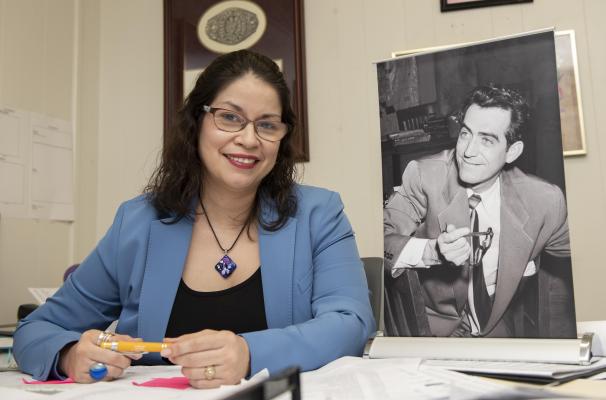Diaz brings court case back to life
By Jessica Coleman
Contributing Writer
Millie Rose Diaz sits behind a desk covered in budget notes, letters to the editor, and post-its scrawled with news story ideas. It is budget time at the Jackson County Herald-Tribune, where she serves as the editor and publisher. She has been up to her ears in annual budget planning for days. Diaz loves her work, and she is proud of it, but today’s change from talking numbers with higher-ups is welcome.
Today, she holds in her hands Feet of Clay, her first published novel. Her eyes light up and her voice takes on a jubilant tone as she holds years of her work between two velvety-smooth book jacket covers, the front cover displaying art by her friend Rene Barrera. The back flap contains a photo of her taken at Jackson County’s own Brackenridge Park.
She speaks of Gus C. García as if he is an old friend – someone she respects, looks up to, and identifies with in many ways. Diaz, an Edna native, was interested in the story of Garcia and his journey to the United States Supreme Court because of the hometown origins. Based on a true story, Feet of Clay is a fictional account that follows García, a real attorney who helped take an Edna-based court case all the way to the U.S. Supreme Court. Garcia, along with attorneys Carlos Cardena and John J. Herrera represented Pete Hernandez, a Mexican American man found guilty of shooting another man, Joe Espinosa, in a bar in Edna in 1951. Hernandez stood trial and faced a jury without a single Mexican American on it. His attorneys would soon discover that no ethnic minorities had served on a jury in Jackson County in a quarter of a century. It was no coincidence. It was the result of systemic corruption, fueled by rich white supremacists.
“It is based on true events, but I used my fiction background to really use a lot of dramatic themes. So, I just went running with it,” Diaz said.
Hernandez v. Texas extended the protections of the 14th Amendment to protect nationality groups, rather than just races defined as black or white. This helped ensure that Mexican American defendants could be tried by juries that included their peers by blocking discrimination that stemmed from Hispanic people being considered white on paper. The court found that while they were defined as white, people with Mexican roots were openly and systemically discriminated against in Jackson County, and across Texas. The Supreme Court ruled in their favor, deciding that the 14th Amendment not only protects racial classes, but nationalities also.
So why haven’t we all heard Garcia’s name? Why isn’t Hernandez v. Texas known throughout the United States?
“Because Brown v. Board of Education happened within two weeks of this outcome,” said Diaz, “And NAACP had so much more in donations than Mexican Americans did at the time. Even with Gus being a flashy character, it got overshadowed.”
Diaz’s novel explores García as an entire human being, who experienced success and helped change the course of history, but also had vices, weaknesses, and difficulties which plagued him and his personal life. It’s a rich, complete view of a complicated man who commanded respect and shouldn’t be defined as just someone who struggled, nor should he be lionized as a perfect human.
“He liked to drink. His vices got ahold of him. He liked sleeping around,” said Diaz. “He loved partying and he loved putting things off until the last second. He was a true ‘silver-tongued devil,’ they called him all the time. He knew what to say to get what he needed. He was a really good-looking man, too. I really fell in love with his story.”
The book also almost didn’t happen, or at the very least, it wouldn’t have happened nearly as quickly without the gentle push from her mentors, Linda J. Reaves and William E. Reaves. Diaz credits them with really making her search for publishers and convincing her to send out proposals.
“The help you’ve given is incalculable,” Diaz said in the acknowledgements of the book.
As for Diaz, writing this book has helped her further appreciate her own identity, both as a Mexican American woman and as the product of a small town in south Texas.
“When I learned it happened here in Edna, I understood finally why I felt like such a small-town girl with a big mind. I would wonder, ‘Why was I born here, in such a small town? But now I feel like I was meant to tell this story.”
Feet of Clay: Gus C. García, Tragic Hero of the Civil Rights Movement, published by Texas Christian University Press, is available at the Jackson County Herald-Tribune, and on Amazon.com, as well as anywhere else books are sold.

